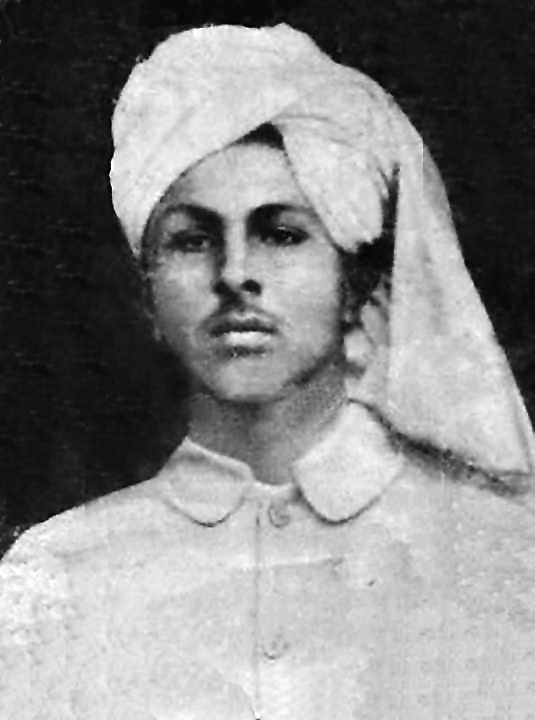
Sarika Sharma
For decades, a bundle of papers lay unopened at the house of Bhagat Singh's younger brother. When it was opened recently, it brought along a new insight into the life of the revolutionary who embraced death at the age of 23. The most intriguing documents from the cache are pages from an unfinished biography of Bhagat Singh by his younger brother Ranbir Singh. Having seen the man up close and personal, his account sifts fact from myth that Punjab and the rest of the country has liked to perpetuate in the 87 years since his death.
The papers were found from the house of Ranbir Singh's son, Maj-Gen Sheonan Singh (retd). The former Army officer says that, for years, he had seen his father taking notes in Urdu, never being able to finish it.
The writing takes one back to Bangay, their tiny village with just about 70 houses, in what is now Lyallpur in Pakistan. He says Bhagat Singh was physically weak and liked to piggyback on others, entertaining them with funny anecdotes en route. At the village pond, the boys would play in water, come out and again play on its muddy banks, only to get dirty again. Just like a typical village boy... So, what shaped Bhagat Singh into a revolutionary, one of the rare freedom fighters to have earned the sobriquet of shaheed or martyr?
Early on, his father would bring for the brothers pamphlets on biographies of freedom fighters from across the world and stories of their struggle, like the French Revolution. That was his first brush with freedom and might have set him thinking, pining for the same for his country. Even as a young kid, he would spend hours lost in thought.
A shadow of his elder brother Jagat Singh, when they would be moseying through the village, people would ask them what they wanted to be. Jagat Singh, who published a cartoon magazine at the age of six, would say, “I will run a newspaper.” Bhagat Singh would say: “I will sow guns.” His revolutionary streak was reflected even at that age.
Dissent from the British government and love for the nation ran in the family. The earliest influence on him was that of his uncle, Ajit Singh, who, along with freedom fighter Sufi Amba Prasad, formed one of the first revolutionary groups in India. Ajit Singh had been exiled to Iran along with Amba Prasad and people would ask the three-year-old where his uncle was. He would say he has gone to a faraway place, to kill the British and he would return after he had shooed them away. This too was to come true. The British left India in 1947, the year Ajit Singh returned. However, he died the night India gained freedom.
Ranbir Singh recounts Bhagat Singh's conversations with friends as later shared with him by these people. To one, he told that the biggest heroes, the greatest influences on his life were uncle Ajit Singh and his comrades, who put the nation before their lives. He said that the story of their exile, their selfless sacrifices shaped his thinking, that their journey to freedom had become too long. He often compared their life to that of the leaders of the nation, who he thought were petty and driven by motives.
The grandfather, Arjun Singh, was a nationalist at heart too. When it was time for the two brothers to be given the sacred thread, janeu, Arjun Singh announced to the people gathered: “I have decided to prepare these boys to serve the nation. They will sacrifice their lives for the country.” While Jagat Singh fell ill the next year and died, the words were to come true for Bhagat Singh in 1931, when he was hanged to death by the British in the Lahore Conspiracy Case.
A Punjabi translation of the book is now coming out. Chandigarh-based publisher Harish Jain says that the edition would be the most authentic account of the martyr's childhood. “Going by the papers I found from his house, he had started collecting material related to Bhagat Singh four-five years after his death, though he started writing a little late, around 1940s, when he came of age. There are papers from pre-Partition India. However, it is unfortunate that he could not retain most of the papers. Apparently, he gave them away to people who came visiting him. “Those papers never came back.”
He says both Ranbir and his son General Sheonan have never felt the need to cash in on Bhagat Singh's legacy; they didn't want to live in that glow. “That's the stand they took in opposition to the other brothers and sisters,” he says.
Fearless, at 15
Driven by the desire to die for the country, hordes of people would take off on the march for freedom. The 13th Shaheedi Jatha (jathas were at the core of the Gurdwara Reform Movement started by the Sikhs in the early 20th century) was on its way to Jaito and the British government was under pressure to not let any public support come its way. There were orders to not to give ration to these freedom fights. But 15-year-old Bhagat Singh had to, and he had to make a point. So, he went, with food on his head as the police looked on.



























